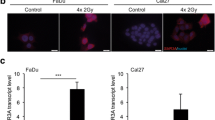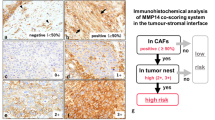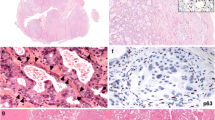Abstract
Recently, increased expression of the submaxillary gland androgen-regulated protein 3A (SMR3A) was found in recurrent tumors of an orthotopic floor-of-mouth mouse tumor model after surgery. However, SMR3A expression in the pathogenesis of human malignancy and its correlation with the clinical outcome have not been addressed so far. We analyzed tissue microarrays with specimens from oropharyngeal squamous cell carcinoma (OPSCC) patients (n = 157) by immunohistochemistry and compared SMR3A expression with clinical and pathological features by statistical analysis. Strong SMR3A expression was found in almost 36 % of all primary OPSCCs. Although, SMR3A protein levels were not associated with any clinical or histopathological feature tested, univariate Kaplan–Meier analysis revealed a significant correlation between high SMR3A protein expression and poor progression-free (p = 0.02) and overall survival (p = 0.03). Furthermore, high SMR3A expression was an independent marker for poor clinical outcome [HR (SMR3Ahigh vs. SMR3low) = 2.32; 95 % CI = 1.03–5.23] concerning overall survival in a multivariate analysis of OPSCC patients with surgery as primary therapy (n = 100). Our data demonstrate for the first time increased SMR3A protein expression in the pathogenesis of OPSCC, which serves as an unfavorable risk factor for patient survival.



Similar content being viewed by others
References
Pai SI, Westra WH (2009) Molecular pathology of head and neck cancer: implications for diagnosis, prognosis, and treatment. Annu Rev Pathol 4:49–70
Argiris A, Karamouzis MV, Raben D, Ferris RL (2008) Head and neck cancer. Lancet 371:1695–1709
Fakhry C, Gillison ML (2006) Clinical implications of human papillomavirus in head and neck cancers. J Clin Oncol 24:2606–2611
Psyrri A, Gouveris P, Vermorken JB (2009) Human papillomavirus-related head and neck tumors: clinical and research implication. Curr Opin Oncol 21:201–205
Leemans CR, Braakhuis BJ, Brakenhoff RH (2011) The molecular biology of head and neck cancer. Nat Rev Cancer 11:9–22
Kostareli E, Holzinger D, Hess J (2012) New concepts for translational head and neck oncology: lessons from HPV-related oropharyngeal squamous cell carcinomas. Front Head Neck Cancer 2:1–10
Molinolo AA, Amornphimoltham P, Squarize CH, Castilho RM, Patel V, Gutkind JS (2009) Dysregulated molecular networks in head and neck carcinogenesis. Oral Oncol 45:324–334
Behren A, Kamenisch Y, Muehlen S, Flechtenmacher C, Haberkorn U, Hilber H, Myers JN, Bergmann Z, Plinkert PK, Simon C (2010) Development of an oral cancer recurrence mouse model after surgical resection. Int J Oncol 36:849–855
Acuna Sanhueza G, Faller L, George B, Koffler J, Misetic V, Flechtenmacher C, Dyckhoff G, Plinkert P, Angel P, Simon C, Hess J (2012) Opposing function of MYBBP1A in proliferation and migration of head and neck squamous cell carcinoma cells. BMC Cancer 12:72
Tong Y, Tar M, Melman A, Davies K (2008) The opiorphin gene (ProL1) and its homologues function in erectile physiology. BJU Int 102:736–740
Wisner A, Dufour E, Messaoudi M, Nejdi A, Marcel A, Ungeheuer MN, Rougeot C (2006) Human Opiorphin, a natural antinociceptive modulator of opioid-dependent pathways. Proc Natl Acad Sci USA 103:17979–17984
Davies KP (2009) The role of opiorphins (endogenous neutral endopeptidase inhibitors) in urogenital smooth muscle biology. J Sex Med 6(Suppl 3):286–291
Holzinger D, Schmitt M, Dyckhoff G, Benner A, Pawlita M, Bosch FX (2012) Viral RNA patterns and high viral load reliably define oropharynx carcinomas with active HPV16 involvement. Cancer Res doi:10.1158/0008-5472.CAN-11-3934
Schmitt M, Bravo IG, Snijders PJ, Gissmann L, Pawlita M, Waterboer T (2006) Bead-based multiplex genotyping of human papillomaviruses. J Clin Microbiol 44:504–512
Schmitt M, Dondog B, Waterboer T, Pawlita M (2008) Homogeneous amplification of genital human alpha papillomaviruses by PCR using novel broad-spectrum GP5+ and GP6+ primers. J Clin Microbiol 46:1050–1059
Schmitt M, Dalstein V, Waterboer T, Clavel C, Gissmann L, Pawlita M (2010) Diagnosing cervical cancer and high-grade precursors by HPV16 transcription patterns. Cancer Res 70:249–256
Roesch Ely M, Nees M, Karsai S, Magele I, Bogumil R, Vorderwulbecke S, Ruess A, Dietz A, Schnolzer M, Bosch FX (2005) Transcript and proteome analysis reveals reduced expression of calgranulins in head and neck squamous cell carcinoma. Eur J Cell Biol 84:431–444
Leon X, Quer M, Orus C, del Prado Venegas M, Lopez M (2000) Distant metastases in head and neck cancer patients who achieved loco-regional control. Head Neck 22:680–686
Chen ZG (2007) Exploration of metastasis-related proteins as biomarkers and therapeutic targets in the treatment of head and neck cancer. Curr Cancer Drug Targets 7:613–622
Rougeot C, Messaoudi M, Hermitte V, Rigault AG, Blisnick T, Dugave C, Desor D, Rougeon F (2003) Sialorphin, a natural inhibitor of rat membrane-bound neutral endopeptidase that displays analgesic activity. Proc Natl Acad Sci USA 100:8549–8554
Maguer-Satta V, Besancon R, Bachelard-Cascales E (2011) Concise review: neutral endopeptidase (CD10): a multifaceted environment actor in stem cells, physiological mechanisms, and cancer. Stem Cells 29:389–396
Papandreou CN, Usmani B, Geng Y, Bogenrieder T, Freeman R, Wilk S, Finstad CL, Reuter VE, Powell CT, Scheinberg D, Magill C, Scher HI, Albino AP, Nanus DM (1998) Neutral endopeptidase 24.11 loss in metastatic human prostate cancer contributes to androgen-independent progression. Nat Med 4:50–57
Gohring B, Holzhausen HJ, Meye A, Heynemann H, Rebmann U, Langner J, Riemann D (1998) Endopeptidase 24.11/CD10 is down-regulated in renal cell cancer. Int J Mol Med 2:409–414
Bunn PA Jr, Helfrich BA, Brenner DG, Chan DC, Dykes DJ, Cohen AJ, Miller YE (1998) Effects of recombinant neutral endopeptidase (EC 3.4.24.11) on the growth of lung cancer cell lines in vitro and in vivo. Clin Cancer Res 4:2849–2858
Sumitomo M, Shen R, Walburg M, Dai J, Geng Y, Navarro D, Boileau G, Papandreou CN, Giancotti FG, Knudsen B, Nanus DM (2000) Neutral endopeptidase inhibits prostate cancer cell migration by blocking focal adhesion kinase signaling. J Clin Invest 106:1399–1407
Horiguchi A, Zheng R, Goodman OB Jr, Shen R, Guan H, Hersh LB, Nanus DM (2007) Lentiviral vector neutral endopeptidase gene transfer suppresses prostate cancer tumor growth. Cancer Gene Ther 14:583–589
Osman I, Dai J, Mikhail M, Navarro D, Taneja SS, Lee P, Christos P, Shen R, Nanus DM (2006) Loss of neutral endopeptidase and activation of protein kinase B (Akt) is associated with prostate cancer progression. Cancer 107:2628–2636
Erhuma M, Kobel M, Mustafa T, Wulfanger J, Dralle H, Hoang-Vu C, Langner J, Seliger B, Kehlen A (2007) Expression of neutral endopeptidase (NEP/CD10) on pancreatic tumor cell lines, pancreatitis and pancreatic tumor tissues. Int J Cancer 120:2393–2400
Acknowledgments
We gratefully acknowledge Nataly Henfling, Ines Kaden and Antje Schuhmann for excellent technical assistance, and Michael Pawlita, Franz X. Bosch, Efterpie Kostareli, Pilar Bayo Zaera and Regina Mark for helpful discussion and critical reading of the manuscript. We thank the tissue bank of the National Center for Tumor Disease (Institute of Pathology, University Hospital Heidelberg) for providing paraffin-embedded tumor specimens of HNSCC patients. This work was supported by the Deutsche Forschungsgemeinschaft (PhD grant of the Graduiertenkolleg 793 to D.H., and HE5760/1-1 to J.H.), the Dietmar Hopp Stiftung (to D.H., P.K.P, and J.H.), and the Stiftung Tumorforschung Kopf-Hals (to J.H.).
Conflict of interest
The authors declare that they have no conflict of interest.
Author information
Authors and Affiliations
Corresponding author
Additional information
J. Koffler and D. Holzinger contributed equally to this study.
Electronic supplementary material
Below is the link to the electronic supplementary material.
Rights and permissions
About this article
Cite this article
Koffler, J., Holzinger, D., Sanhueza, G.A. et al. Submaxillary gland androgen-regulated protein 3A expression is an unfavorable risk factor for the survival of oropharyngeal squamous cell carcinoma patients after surgery. Eur Arch Otorhinolaryngol 270, 1493–1500 (2013). https://doi.org/10.1007/s00405-012-2201-6
Received:
Accepted:
Published:
Issue Date:
DOI: https://doi.org/10.1007/s00405-012-2201-6




